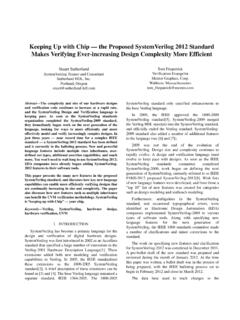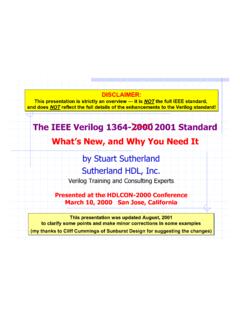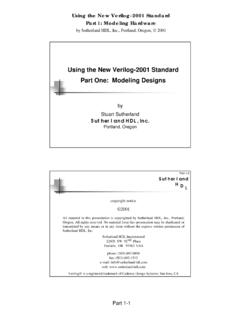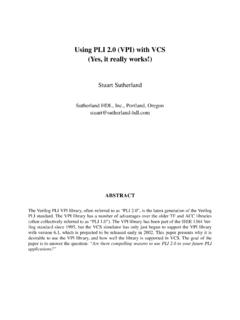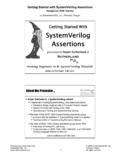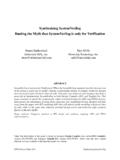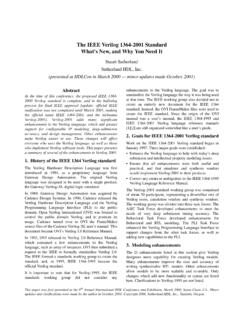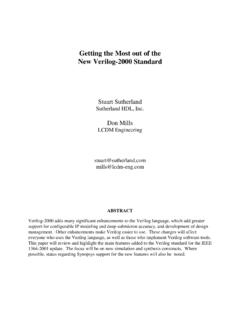Transcription of SystemVerilog 'uinique' and 'priority' are the new Heroes
1 SystemVerilog Saves the Day the evil twins are Defeated! unique and priority are the new Heroes Stuart Sutherland Sutherland HDL, Inc. ABSTRACT. Abstract: The villains of synthesis for many a design are the parallel_case and full_case . synthesis pragmas. The dastardly deeds of these infamous pragmas have been well documented in a past SNUG paper, full_case parallel_case', the evil twins of Verilog Synthesis , by Clifford Cummings[6]. Despite this excellent paper, these pragmas are still misunderstood and are abused by many design engineers. SystemVerilog introduces two new synthesis Heroes , unique and priority . These new keywords are intended to replace the villainous twin pragmas. This paper discusses in depth the purpose of the unique and priority decision modifiers, and how they affect simulation, synthesis, and formal verification.
2 Comparisons between the SystemVerilog keywords and the infamous pragmas are made. These comparisons show how SystemVerilog 's unique and priority keywords provide all the advantages of the full_case/parallel_case synthesis pragmas, and eliminate the disadvantages that made these pragmas villains. Guidelines on the proper usage of the unique and priority keywords are presented, showing how these decision modifiers should be properly used. Introduction This focus of this paper on the proper modeling, simulation and synthesis of multiple-branch decisions. The goal of this paper is two-fold: First, to ensure that the design engineer's assumptions about each and every multiple-branch decision in a design is correct. Second, to ensure that synthesis compilers will correctly implement what the design engineer specified.
3 The concepts presented in this paper are based on the following key principles: Software simulation works differently than hardware. The Synopsys DC synthesis tool generally tries to match simulation behavior. Engineers occasionally need to be smarter than synthesis. Software works differently than hardware Software and hardware do not work the same way. Software programs execute sequentially, as a serial stream of instructions, whereas hardware is very parallel in its execution. These differences are readily apparent in how a multiple-branch decision is executed, as shown in the following two examples. SNUG San Jose 2005 1 SystemVerilog unique and priority Decisions Example 1 illustrates one way in which the difference between software and hardware is manifest: module mux3to1a (output reg y, input a, b, c, input [1:0] select ).
4 Always @* begin if (select == 2'b00) y = a;. else if (select == 2'b01) y = b;. else if (select == 2'b10) y = c;. end endmodule Example 1 3-to-1 MUX using multiple decisions (Verilog language, keywords in bold). In software, the select values will be tested one at a time, in the order in which the values are listed in the code. As soon as the first match is found, no other values are tested. If the value of select does not match any of the branches (a value of 2'b11, in this example), then no action is taken, and the output of the MUX remains unchanged. Hardware, unless specifically designed otherwise, will evaluate this example very differently. In hardware, all four values of select will be evaluated in parallel. The decode of these four possible values will cause one branch to be selected.
5 If the value of select is 2'b11, the output of the MUX will be set to some value, but that value cannot be determined without examining the actual transistors that make up the decode logic. In order to force hardware to match software behavior, additional hardware is required, probably in the form of latch circuitry, so that the value of the output is not changed when the select input has a value of 2'b11. Example 2 illustrates another difference in how software and hardware will evaluate a multiple- branch decision. This example illustrates an interrupt decoder. module interrupt_decode1 (output reg something, input [3:0] IRQ );. always @* begin if (IRQ[0]) // test if IRQ bit 0 is set // process interrupt 0. else if (IRQ[1]) // test if IRQ bit 1 is set // process interrupt 1.
6 Else if (IRQ[2]) // test if IRQ bit 2 is set // process interrupt 2. else if (IRQ[3]) // test if IRQ bit 3 is set // process interrupt 3. else // process default for no interrupt end endmodule Example 2 Interrupt decoder with 4 possible interrupts In software, the IRQ interrupt bits will be tested one at a time, in the order in which the bits are listed in the code. As soon as one of the bits tests as true, no other bits are tested. If no bits are set, then no action is taken. Hardware, unless specifically designed otherwise, will evaluate this SNUG San Jose 2005 2 SystemVerilog unique and priority Decisions example very differently. If multiple IRQ bits are set, multiple actions will be executed in parallel. To make hardware evaluate this multiple-branch decision in the same way as software, priority encoding logic would need to be added to the design.
7 The Synopsys DC synthesis tool generally tries to match simulation behavior A primary role of The Synopsys DC synthesis tool is to transform abstract programming statements into a hardware implementation. DC is reasonably intelligent, and will try to generate an implementation that approximates the software simulation behavior as closely as possible. In Example 1, above, DC will add latched logic to the 3-to-1 MUX circuitry, to maintain the behavior that the output will remain unchanged for a select value of 2'b11. For Example 2, DC. will add priority encoded logic so that the IRQ bits are evaluated in the same order as they are in simulation, and so that only the first IRQ bit that is set will cause an action to be taken.
8 Engineers occasionally need to be smarter than synthesis Sometimes it is necessary for engineers to override the default behavior of the synthesis tool. For example, it may be that, in the 3-to-1 MUX example, it is impossible for a select value of 2'b11. to occur. Therefore, the extra logic to latch the MUX output is not necessary, and can be removed from the hardware circuitry. In the interrupt decoder example, an engineer might know that there will never be two IRQ bits set at the same time, and, therefore, it is not necessary for the hardware to evaluate the IRQ bits in the same order as the software simulation model. DC provides a way for an engineer to override how synthesis will interpret a decision statement. However, if an engineer is mistaken about the design assumptions, overriding the default synthesis behavior will very likely result in circuitry that does not work correctly.
9 Verilog decision statements syntax and semantics [ If you already know how the Verilog and case statements work, then you can skip this section, and jump to section 3 ]. In order to ensure that decision statements correctly model intended functionality, and will synthesize to the correct hardware implementation, it is important to understand the simulation semantics of decision statements. The Verilog standard provides four decision statements: , case, casez and casex. The syntax and simulation semantics of each of these are discussed in the following subsections. All Verilog decision statements are procedural (programming) statements, and must be specified in a procedural block context. Verilog procedural blocks are initial blocks, always blocks, task and function.
10 SystemVerilog adds a final procedural block. Verilog decisions The syntax of the Verilog statement is straightforward, and similar to the C language: if ( expression ) statement_or_statement_group else statement_or_statement_group SNUG San Jose 2005 3 SystemVerilog unique and priority Decisions For example: always @(posedge clock). if (!reset) begin r1 <= 0;. r2 <= 0;. end else begin r1 <= opcode;. r2 <= operand;. end Example 3 Verilog statement The expression can be anything in Verilog that has a logic value, including nets, variables, constants and literal values. The expression can also be the result of an operation, such as a concatenation or the not ( ! ) operator. If the value of the expression evaluates to true, then the statement or group of statements following the expression are executed.
